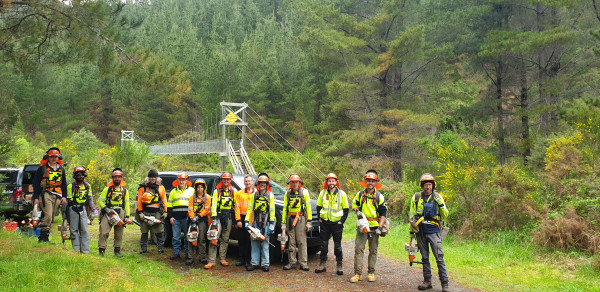The Mount Richmond Forest Park (MRFP) located in Te Tau Ihu (top of the South Island) is an area of national significance, with unique ecosystems that includes native plant species found nowhere else in the country. The unique ultramafic strata (igneous rocks usually found on the Earth’s mantle rather than the crust) contains special minerals suited to only a few native floras like the nationally endangered Red Hills Forget-Me-Not and the Red Hills Geranium. Although this type of geology makes it difficult for most woody species to grow there, wilding conifers thrive, shading out native vegetation.
In late 2020, Tasman District council teamed up with PF Olsen, independent forestry management providers, to remove wilding conifer infestation from the MRFP. The four-year project is funded by the National Wilding Conifer Control Programme, through Biosecurity New Zealand (BNZ), a business unit of the Ministry for Primary Industries (MPI) as well as further funding through the Department of Conservation under the Jobs for Nature Programme. The project aims to remove wilding conifers from the MRFP management unit then carry out further work to ensure they don’t return. A management unit (MU) is a defined geographical area for the purposes of planning wilding conifer control activities by the National Wilding Conifer Control Programme.
“The reality is that not all wildings will be removed from the MRFP within four years. It will be a much longer timescale than this. And it will take further work to ensure they don’t return.” George Daly, Project Manager from Tasman District Council said.
The MRFP covers around 283,000 hectares and traverses through private, public and conservation lands making the removal of wilding conifers an impossible task to achieve without collaboration between many key parties.
“This funding has been hugely beneficial to our region, not only in reducing the spread of the wilding conifers, but also in providing local employment and up skilling opportunities in a Covid-19 affected job market,” Liam Watson, Forest Manager (Nelson) at PF Olsen said.

Liam Watson (third from the right) and his crew in the Hackett operational management area, ready to start ‘drill and fill’ operations for the 2021/2022 season
“All of our work in Mount Richmond Forest Park is guided by the MRFP MU Wilding Conifer Stakeholder Group who meet regularly to share knowledge and work together on control activities in the region,” Liam said.
“The Stakeholder Group members include the Ministry for Primary Industries, Department of Conservation, Nelson City Council, Tasman District Council, Marlborough District Council, local forestry companies (OneFortyOne New Zealand Ltd and Tasman Pine Forests Ltd), local Iwi representatives and private landowners (when required) to facilitate access for control operations and to decide on the strategic priorities for the project.”
Wilding control is a recent addition to PF Olsens range of services in Nelson. The company ensures new recruits to wilding control work undergo stringent training protocols that cover both health and safety, and environmental related issues. The training includes identifying wilding tree species by unique characteristics like the bark, foliage/needles and cones to determine the appropriate treatment technique and chemical that should be applied.
“Identification of planted conifers vs wilding conifers is relatively easy,” said Liam. “We provide our contractors with detailed geo-referenced maps and GPS files showing control area boundaries. These maps and files are then loaded into the operators' GPS devices and cell phones and allow the operators to navigate and define the control area boundaries.”
Since the start of the project, the PF Olsen crew and their contractors have treated over 11,000 hectares of land affected by wilding conifer infestations in MRFP, totalling to around $1.45 million spent on control operations in 2020/2021.
“Of the total land at MRFP that has received control, we’ve treated around 321 hectares with ground-based herbicide injection (‘drill and fill’ methods) and around 10,924 hectares with Aerial Basal Bark Application (ABBA) method.” Liam said.
“Mount Richmond Forest Park is rich with rare species and ecosystems, as well as being a popular area for outdoor recreation. Last year the National Wilding Conifer Control Programme together with our partners, made huge progress on removing wildings from the Park. It really highlights the benefit of collaboration between so many key parties, including neighbouring forest owners and managers– a job well done to all!” Sherman Smith, National Wilding Conifer Control Programme Manager said.